engine oil FORD F650 2015 13.G Owners Manual
[x] Cancel search | Manufacturer: FORD, Model Year: 2015, Model line: F650, Model: FORD F650 2015 13.GPages: 384, PDF Size: 4.95 MB
Page 5 of 384
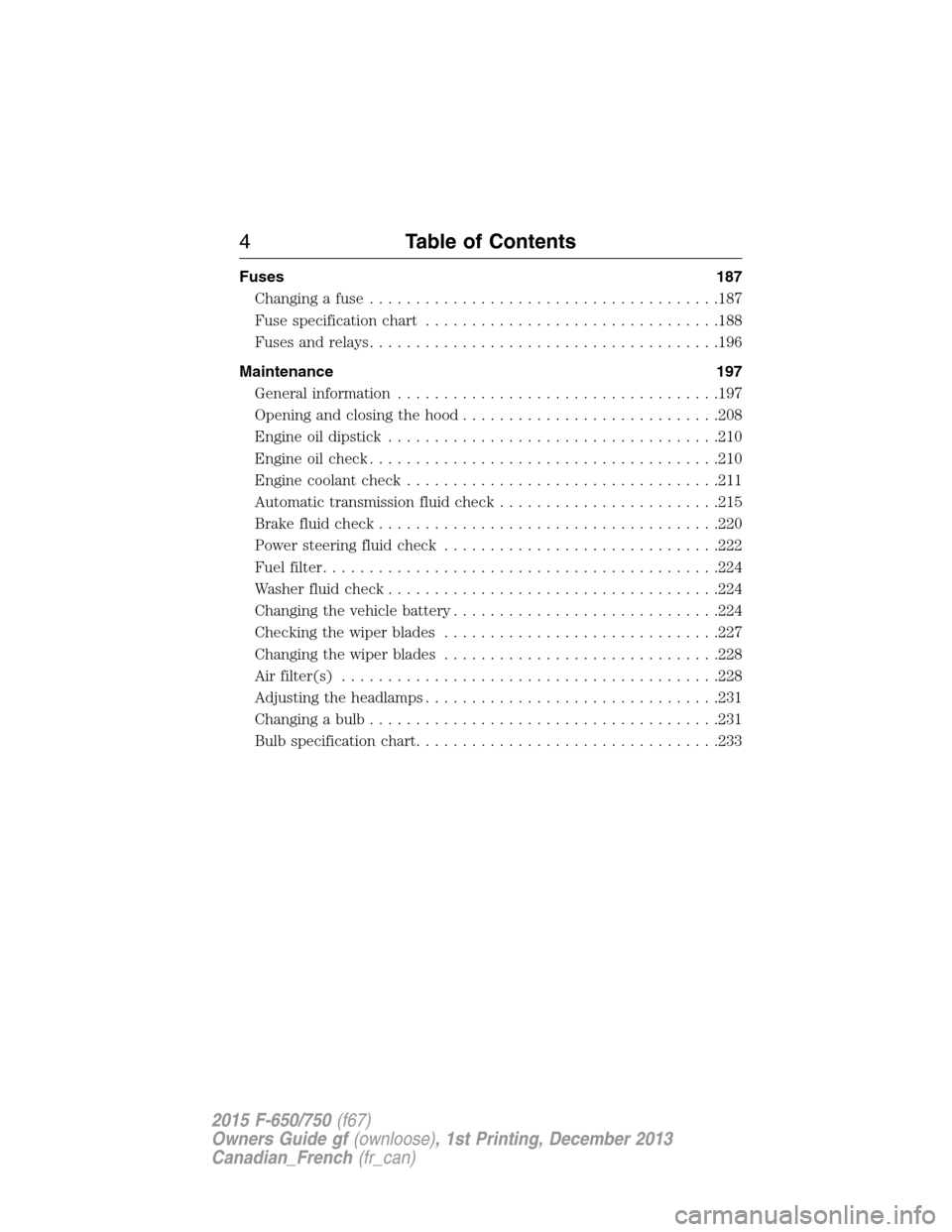
Fuses 187
Changing a fuse......................................187
Fuse specification chart................................188
Fuses and relays......................................196
Maintenance 197
General information...................................197
Opening and closing the hood............................208
Engine oil dipstick....................................210
Engine oil check......................................210
Engine coolant check..................................211
Automatic transmission fluid check........................215
Brake fluid check.....................................220
Power steering fluid check..............................222
Fuel filter...........................................224
Washer fluid check....................................224
Changing the vehicle battery.............................224
Checking the wiper blades..............................227
Changing the wiper blades..............................228
Air filter(s).........................................228
Adjusting the headlamps................................231
Changing a bulb......................................231
Bulb specification chart.................................233
4Table of Contents
2015 F-650/750(f67)
Owners Guide gf(ownloose), 1st Printing, December 2013
Canadian_French(fr_can)
Page 9 of 384
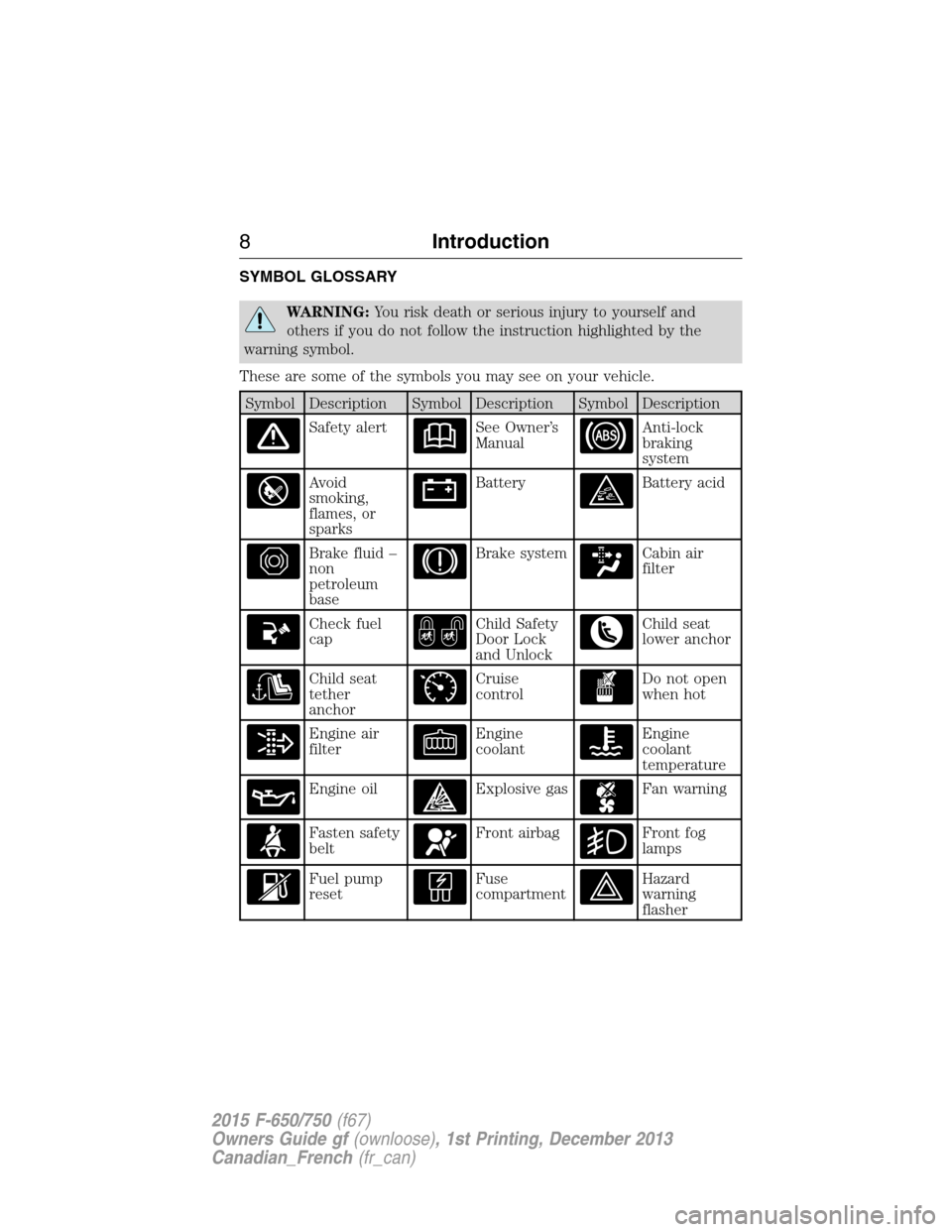
SYMBOL GLOSSARY
WARNING:You risk death or serious injury to yourself and
others if you do not follow the instruction highlighted by the
warning symbol.
These are some of the symbols you may see on your vehicle.
Symbol Description Symbol Description Symbol Description
Safety alertSee Owner’s
ManualAnti-lock
braking
system
Avoid
smoking,
flames, or
sparksBatteryBattery acid
Brake fluid –
non
petroleum
baseBrake systemCabin air
filter
Check fuel
capChild Safety
Door Lock
and UnlockChild seat
lower anchor
Child seat
tether
anchorCruise
controlDo not open
when hot
Engine air
filterEngine
coolantEngine
coolant
temperature
Engine oilExplosive gasFan warning
Fasten safety
beltFront airbagFront fog
lamps
Fuel pump
resetFuse
compartmentHazard
warning
flasher
8Introduction
2015 F-650/750(f67)
Owners Guide gf(ownloose), 1st Printing, December 2013
Canadian_French(fr_can)
Page 15 of 384
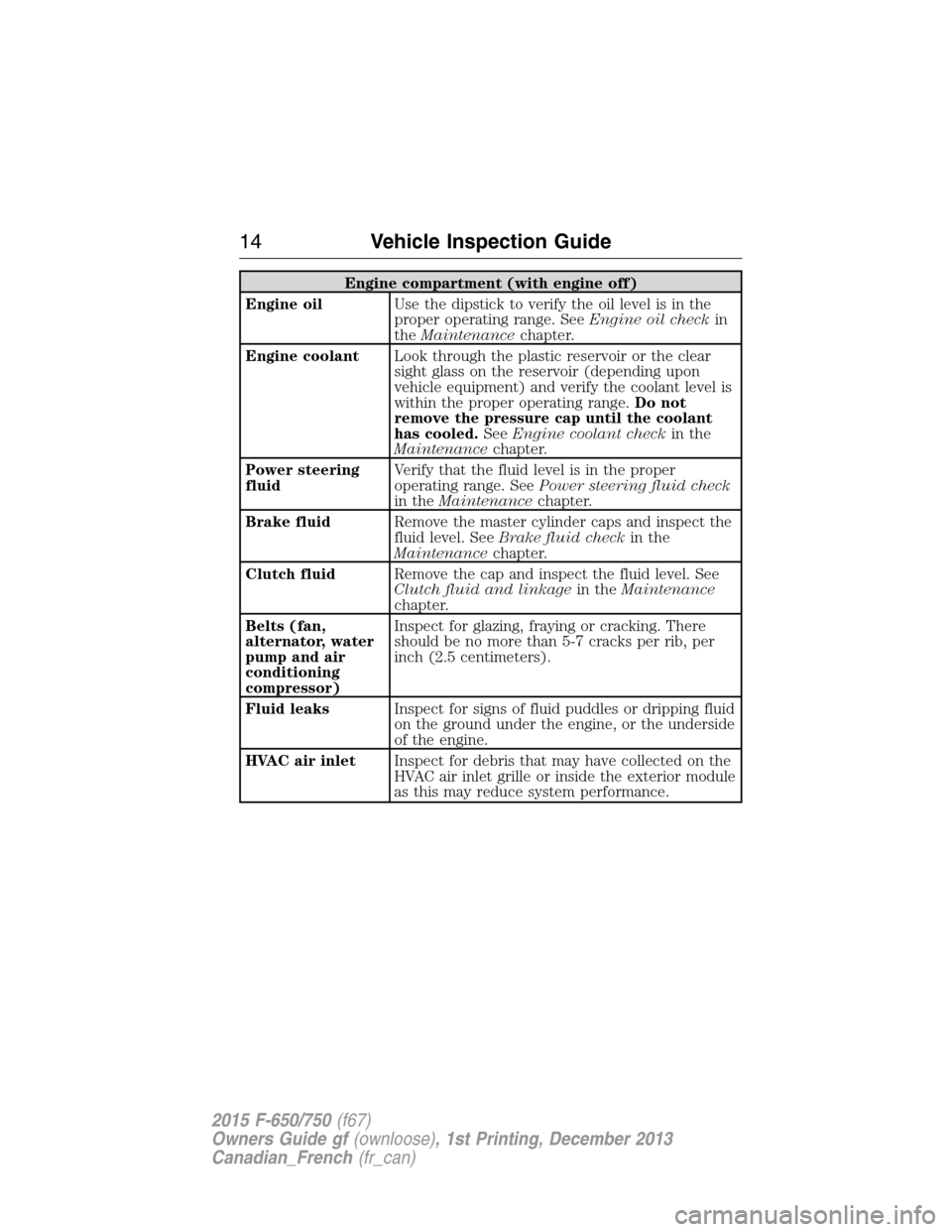
Engine compartment (with engine off)
Engine oilUse the dipstick to verify the oil level is in the
proper operating range. SeeEngine oil checkin
theMaintenancechapter.
Engine coolantLook through the plastic reservoir or the clear
sight glass on the reservoir (depending upon
vehicle equipment) and verify the coolant level is
within the proper operating range.Do not
remove the pressure cap until the coolant
has cooled.SeeEngine coolant checkin the
Maintenancechapter.
Power steering
fluidVerify that the fluid level is in the proper
operating range. SeePower steering fluid check
in theMaintenancechapter.
Brake fluidRemove the master cylinder caps and inspect the
fluid level. SeeBrake fluid checkin the
Maintenancechapter.
Clutch fluidRemove the cap and inspect the fluid level. See
Clutch fluid and linkagein theMaintenance
chapter.
Belts (fan,
alternator, water
pump and air
conditioning
compressor)Inspect for glazing, fraying or cracking. There
should be no more than 5-7 cracks per rib, per
inch (2.5 centimeters).
Fluid leaksInspect for signs of fluid puddles or dripping fluid
on the ground under the engine, or the underside
of the engine.
HVAC air inletInspect for debris that may have collected on the
HVAC air inlet grille or inside the exterior module
as this may reduce system performance.
14Vehicle Inspection Guide
2015 F-650/750(f67)
Owners Guide gf(ownloose), 1st Printing, December 2013
Canadian_French(fr_can)
Page 16 of 384
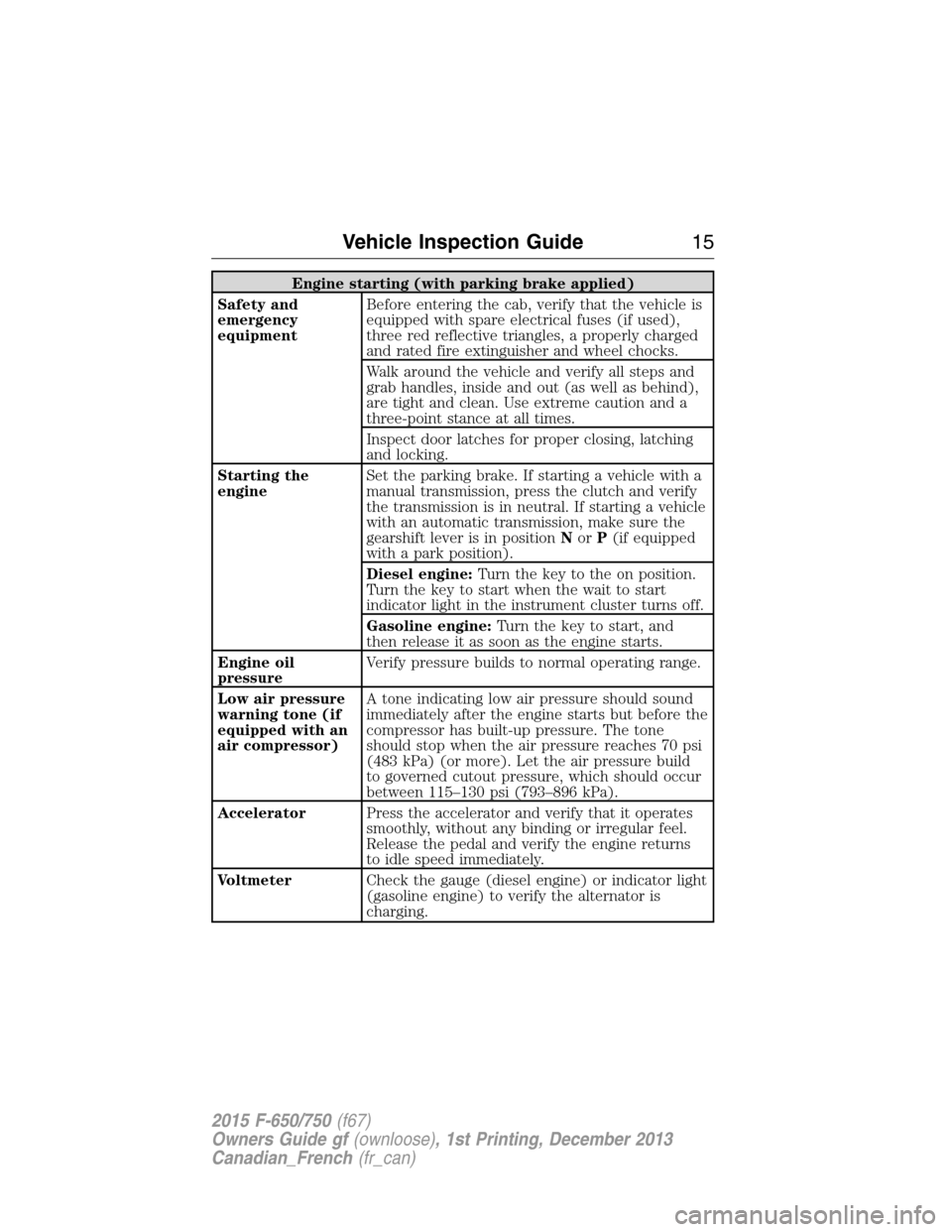
Engine starting (with parking brake applied)
Safety and
emergency
equipmentBefore entering the cab, verify that the vehicle is
equipped with spare electrical fuses (if used),
three red reflective triangles, a properly charged
and rated fire extinguisher and wheel chocks.
Walk around the vehicle and verify all steps and
grab handles, inside and out (as well as behind),
are tight and clean. Use extreme caution and a
three-point stance at all times.
Inspect door latches for proper closing, latching
and locking.
Starting the
engineSet the parking brake. If starting a vehicle with a
manual transmission, press the clutch and verify
the transmission is in neutral. If starting a vehicle
with an automatic transmission, make sure the
gearshift lever is in positionNorP(if equipped
with a park position).
Diesel engine:Turn the key to the on position.
Turn the key to start when the wait to start
indicator light in the instrument cluster turns off.
Gasoline engine:Turn the key to start, and
then release it as soon as the engine starts.
Engine oil
pressureVerify pressure builds to normal operating range.
Low air pressure
warning tone (if
equipped with an
air compressor)A tone indicating low air pressure should sound
immediately after the engine starts but before the
compressor has built-up pressure. The tone
should stop when the air pressure reaches 70 psi
(483 kPa) (or more). Let the air pressure build
to governed cutout pressure, which should occur
between 115–130 psi (793–896 kPa).
AcceleratorPress the accelerator and verify that it operates
smoothly, without any binding or irregular feel.
Release the pedal and verify the engine returns
to idle speed immediately.
VoltmeterCheck the gauge (diesel engine) or indicator light
(gasoline engine) to verify the alternator is
charging.
Vehicle Inspection Guide15
2015 F-650/750(f67)
Owners Guide gf(ownloose), 1st Printing, December 2013
Canadian_French(fr_can)
Page 64 of 384
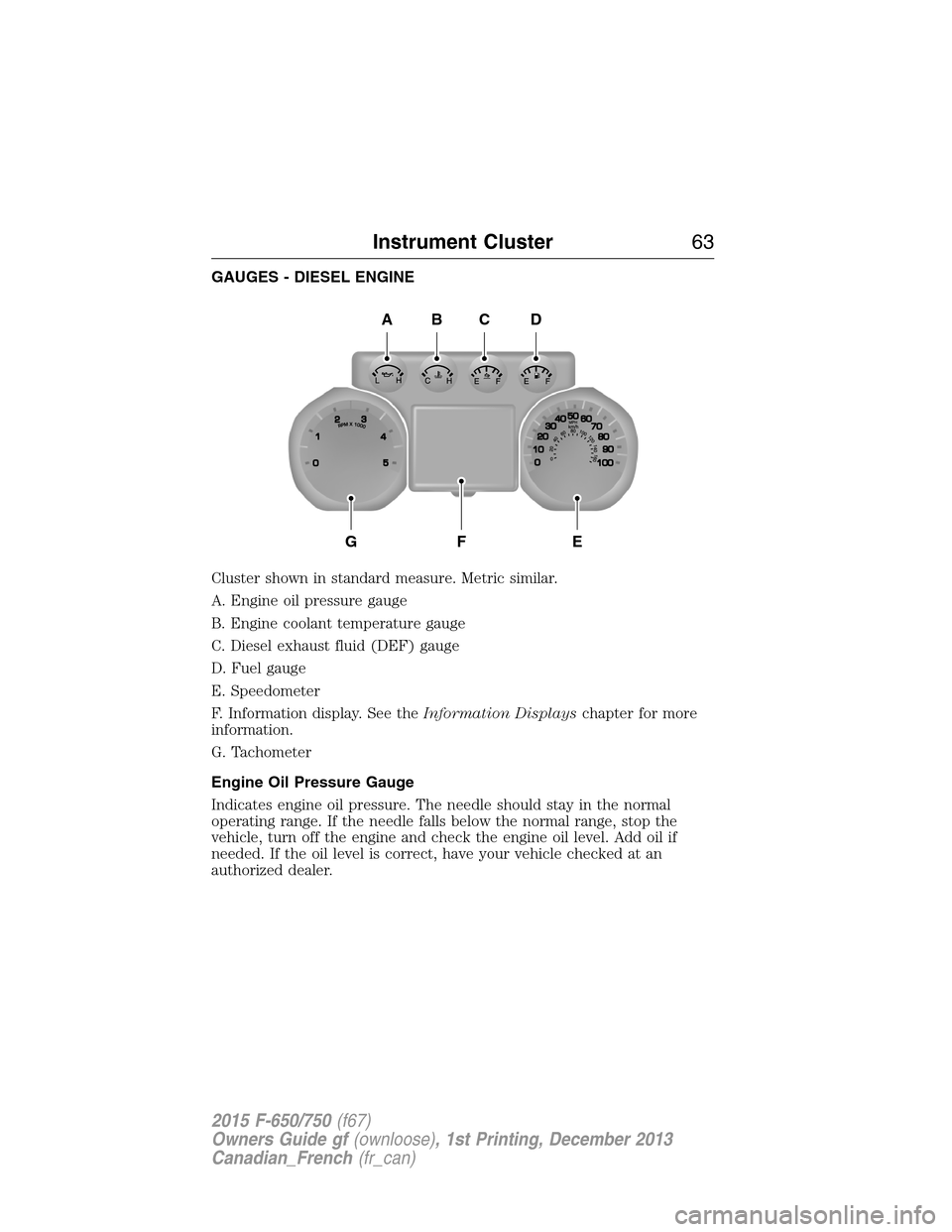
GAUGES - DIESEL ENGINE
Cluster shown in standard measure. Metric similar.
A. Engine oil pressure gauge
B. Engine coolant temperature gauge
C. Diesel exhaust fluid (DEF) gauge
D. Fuel gauge
E. Speedometer
F. Information display. See theInformation Displayschapter for more
information.
G. Tachometer
Engine Oil Pressure Gauge
Indicates engine oil pressure. The needle should stay in the normal
operating range. If the needle falls below the normal range, stop the
vehicle, turn off the engine and check the engine oil level. Add oil if
needed. If the oil level is correct, have your vehicle checked at an
authorized dealer.
A
GFE
BCD
Instrument Cluster63
2015 F-650/750(f67)
Owners Guide gf(ownloose), 1st Printing, December 2013
Canadian_French(fr_can)
Page 66 of 384
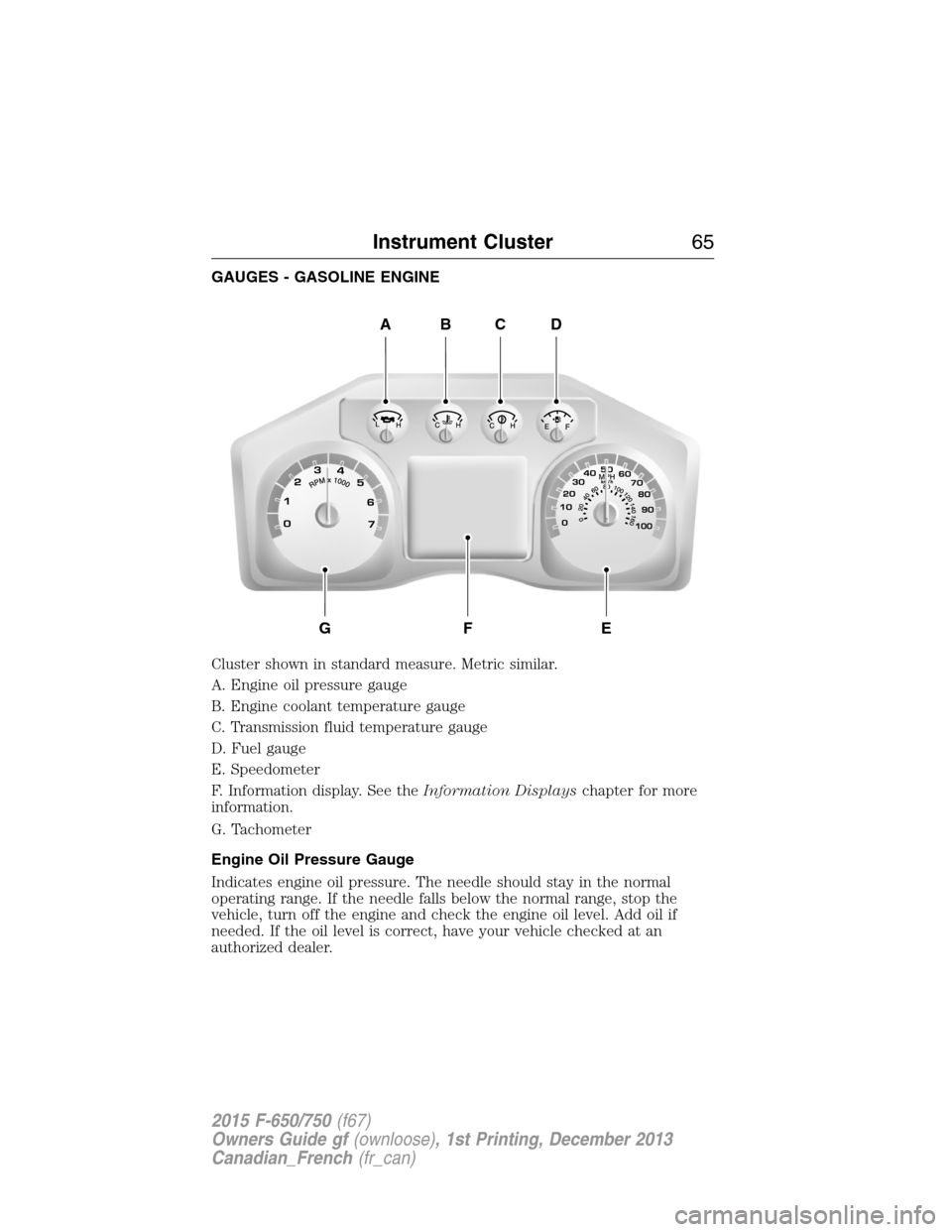
GAUGES - GASOLINE ENGINE
Cluster shown in standard measure. Metric similar.
A. Engine oil pressure gauge
B. Engine coolant temperature gauge
C. Transmission fluid temperature gauge
D. Fuel gauge
E. Speedometer
F. Information display. See theInformation Displayschapter for more
information.
G. Tachometer
Engine Oil Pressure Gauge
Indicates engine oil pressure. The needle should stay in the normal
operating range. If the needle falls below the normal range, stop the
vehicle, turn off the engine and check the engine oil level. Add oil if
needed. If the oil level is correct, have your vehicle checked at an
authorized dealer.
ABCD
GFE
Instrument Cluster65
2015 F-650/750(f67)
Owners Guide gf(ownloose), 1st Printing, December 2013
Canadian_French(fr_can)
Page 70 of 384
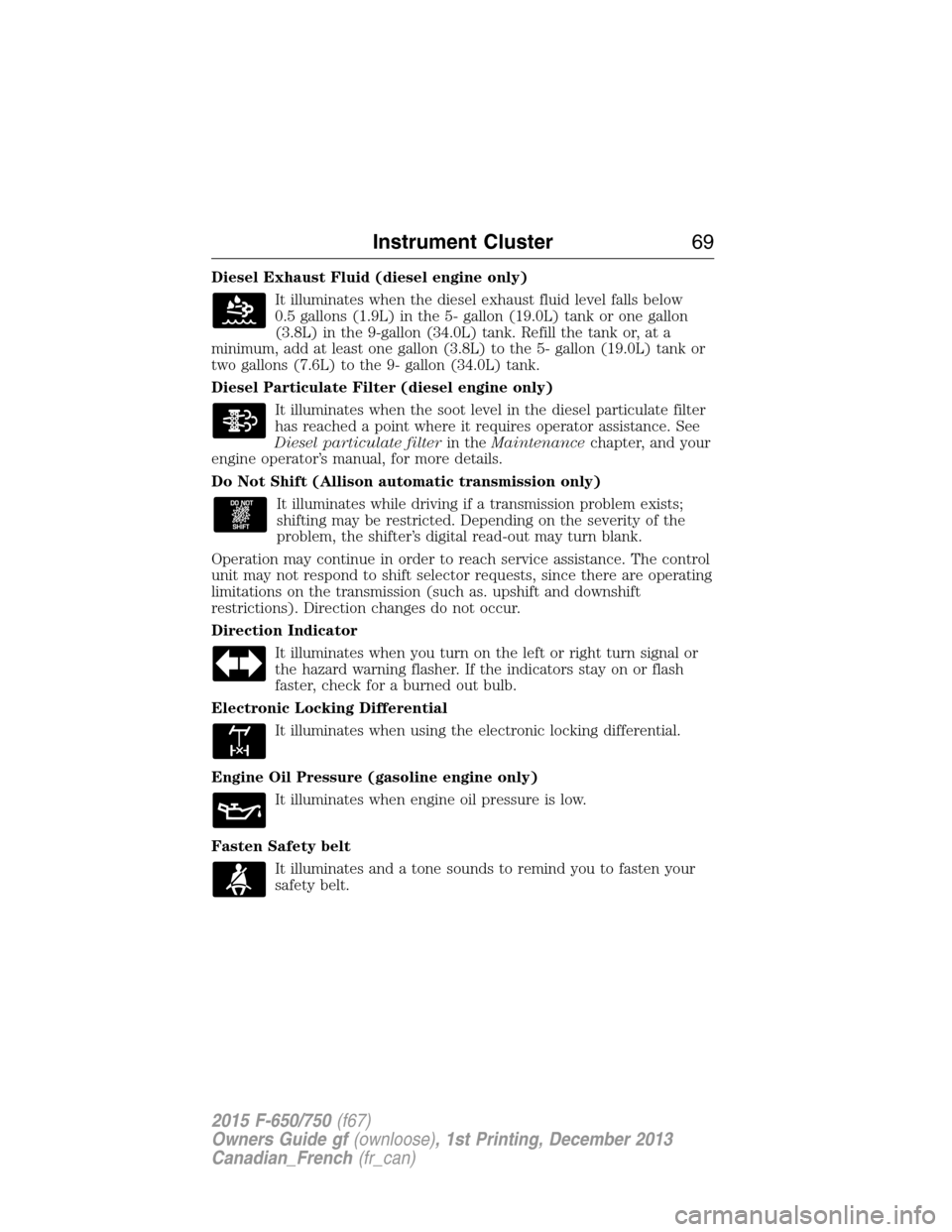
Diesel Exhaust Fluid (diesel engine only)
It illuminates when the diesel exhaust fluid level falls below
0.5 gallons (1.9L) in the 5- gallon (19.0L) tank or one gallon
(3.8L) in the 9-gallon (34.0L) tank. Refill the tank or, at a
minimum, add at least one gallon (3.8L) to the 5- gallon (19.0L) tank or
two gallons (7.6L) to the 9- gallon (34.0L) tank.
Diesel Particulate Filter (diesel engine only)
It illuminates when the soot level in the diesel particulate filter
has reached a point where it requires operator assistance. See
Diesel particulate filterin theMaintenancechapter, and your
engine operator’s manual, for more details.
Do Not Shift (Allison automatic transmission only)
It illuminates while driving if a transmission problem exists;
shifting may be restricted. Depending on the severity of the
problem, the shifter’s digital read-out may turn blank.
Operation may continue in order to reach service assistance. The control
unit may not respond to shift selector requests, since there are operating
limitations on the transmission (such as. upshift and downshift
restrictions). Direction changes do not occur.
Direction Indicator
It illuminates when you turn on the left or right turn signal or
the hazard warning flasher. If the indicators stay on or flash
faster, check for a burned out bulb.
Electronic Locking Differential
It illuminates when using the electronic locking differential.
Engine Oil Pressure (gasoline engine only)
It illuminates when engine oil pressure is low.
Fasten Safety belt
It illuminates and a tone sounds to remind you to fasten your
safety belt.
Instrument Cluster69
2015 F-650/750(f67)
Owners Guide gf(ownloose), 1st Printing, December 2013
Canadian_French(fr_can)
Page 97 of 384
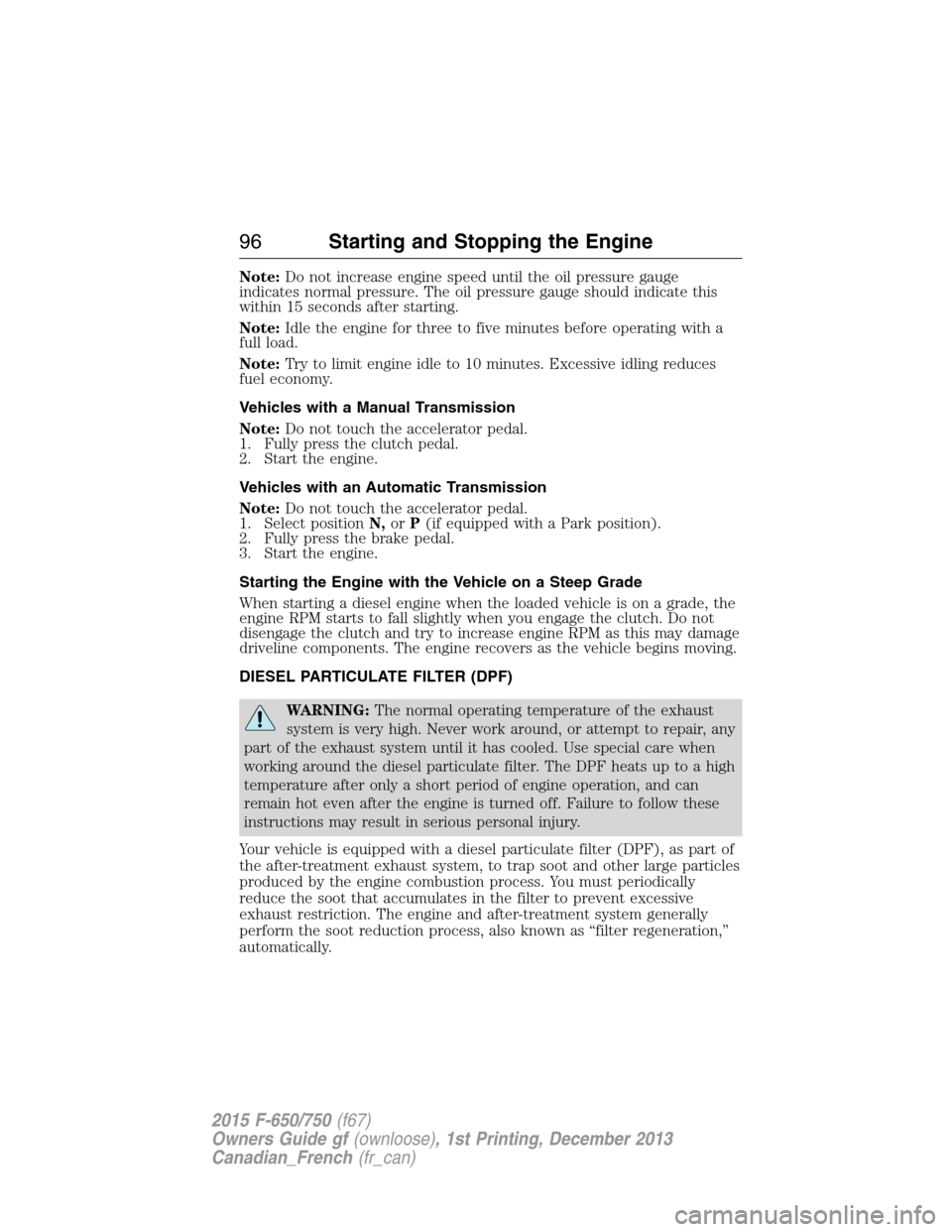
Note:Do not increase engine speed until the oil pressure gauge
indicates normal pressure. The oil pressure gauge should indicate this
within 15 seconds after starting.
Note:Idle the engine for three to five minutes before operating with a
full load.
Note:Try to limit engine idle to 10 minutes. Excessive idling reduces
fuel economy.
Vehicles with a Manual Transmission
Note:Do not touch the accelerator pedal.
1. Fully press the clutch pedal.
2. Start the engine.
Vehicles with an Automatic Transmission
Note:Do not touch the accelerator pedal.
1. Select positionN,orP(if equipped with a Park position).
2. Fully press the brake pedal.
3. Start the engine.
Starting the Engine with the Vehicle on a Steep Grade
When starting a diesel engine when the loaded vehicle is on a grade, the
engine RPM starts to fall slightly when you engage the clutch. Do not
disengage the clutch and try to increase engine RPM as this may damage
driveline components. The engine recovers as the vehicle begins moving.
DIESEL PARTICULATE FILTER (DPF)
WARNING:The normal operating temperature of the exhaust
system is very high. Never work around, or attempt to repair, any
part of the exhaust system until it has cooled. Use special care when
working around the diesel particulate filter. The DPF heats up to a high
temperature after only a short period of engine operation, and can
remain hot even after the engine is turned off. Failure to follow these
instructions may result in serious personal injury.
Your vehicle is equipped with a diesel particulate filter (DPF), as part of
the after-treatment exhaust system, to trap soot and other large particles
produced by the engine combustion process. You must periodically
reduce the soot that accumulates in the filter to prevent excessive
exhaust restriction. The engine and after-treatment system generally
perform the soot reduction process, also known as “filter regeneration,”
automatically.
96Starting and Stopping the Engine
2015 F-650/750(f67)
Owners Guide gf(ownloose), 1st Printing, December 2013
Canadian_French(fr_can)
Page 100 of 384

3. Do not press the accelerator pedal, service brake pedal, or clutch
pedal (manual transmission).
4. The parking brake must remain set.
On average, depending on filter level and other factors, the process takes
20–30 minutes to complete. The DPF lamp turns off when the process is
complete. Repeat Steps 1–5, if parked regeneration is interrupted.
To Discontinue Parked Regeneration
Press any of the floor pedals to discontinue parked regeneration.
Maintenance and Service
The DPF can retain a relatively large amount of residual ash and provide
many miles and hours of maintenance-free operation. At some point,
generally beyond 150000 miles (240000 kilometers) or 5000 hours of
operation (whichever comes first), the DPF requires professional
cleaning to remove the accumulated ash.
The exact number of miles or hours of operation vary greatly depending
upon vehicle and engine loading and operating conditions, ash content of
the engine oil, and quality of the diesel fuel used in your truck. Adhering
to your engine manufacturer’s recommended oil and fuel specifications
maximizes the miles and hours of operation before a DPF professional
cleaning is required. See your engine manufacturer’s owner’s manual for
more details about recommended maintenance and service of your DPF.
Exhaust Outlet Assembly
WARNING:The normal operating temperature of the exhaust
system is very high. Never work around or attempt to repair any
part of the exhaust system until it has cooled. Failure to follow these
instructions may result in serious personal injury.
Note:Do not modify or remove this device. Modification of the system
or additions of aftermarket devices can reduce the effectiveness of the
system, as well as cause damage to the exhaust system or engine. Any
modifications may also invalidate the vehicle or engine warranty. See
your warranty information.
Note:Blocked or plugged holes or modification to, or removal of, the
outlet assembly could result in elevated exhaust temperatures that may
result in vehicle or property damage or personal injury.
The exhaust outlet assembly on your vehicle is a uniquely functioning
device that accompanies the DPF assembly. It can help control the
temperature of the exhaust during the DPF regeneration process.
Starting and Stopping the Engine99
2015 F-650/750(f67)
Owners Guide gf(ownloose), 1st Printing, December 2013
Canadian_French(fr_can)
Page 101 of 384
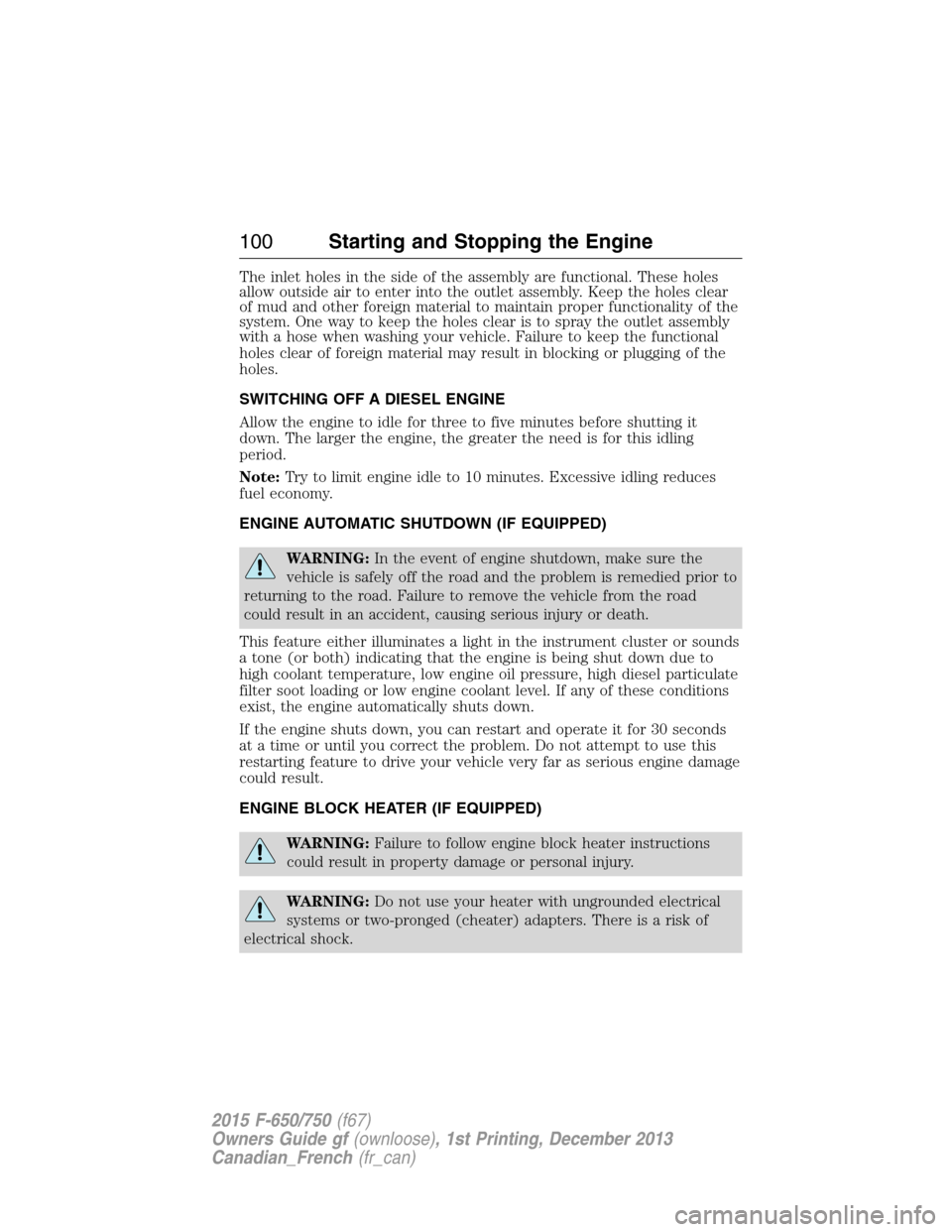
The inlet holes in the side of the assembly are functional. These holes
allow outside air to enter into the outlet assembly. Keep the holes clear
of mud and other foreign material to maintain proper functionality of the
system. One way to keep the holes clear is to spray the outlet assembly
with a hose when washing your vehicle. Failure to keep the functional
holes clear of foreign material may result in blocking or plugging of the
holes.
SWITCHING OFF A DIESEL ENGINE
Allow the engine to idle for three to five minutes before shutting it
down. The larger the engine, the greater the need is for this idling
period.
Note:Try to limit engine idle to 10 minutes. Excessive idling reduces
fuel economy.
ENGINE AUTOMATIC SHUTDOWN (IF EQUIPPED)
WARNING:In the event of engine shutdown, make sure the
vehicle is safely off the road and the problem is remedied prior to
returning to the road. Failure to remove the vehicle from the road
could result in an accident, causing serious injury or death.
This feature either illuminates a light in the instrument cluster or sounds
a tone (or both) indicating that the engine is being shut down due to
high coolant temperature, low engine oil pressure, high diesel particulate
filter soot loading or low engine coolant level. If any of these conditions
exist, the engine automatically shuts down.
If the engine shuts down, you can restart and operate it for 30 seconds
at a time or until you correct the problem. Do not attempt to use this
restarting feature to drive your vehicle very far as serious engine damage
could result.
ENGINE BLOCK HEATER (IF EQUIPPED)
WARNING:Failure to follow engine block heater instructions
could result in property damage or personal injury.
WARNING:Do not use your heater with ungrounded electrical
systems or two-pronged (cheater) adapters. There is a risk of
electrical shock.
100Starting and Stopping the Engine
2015 F-650/750(f67)
Owners Guide gf(ownloose), 1st Printing, December 2013
Canadian_French(fr_can)